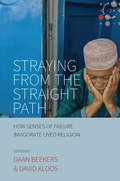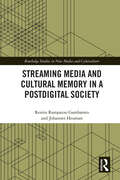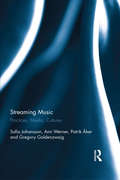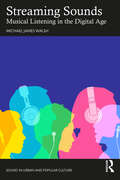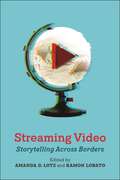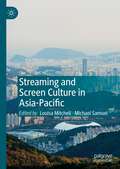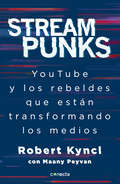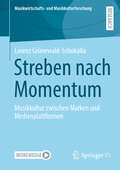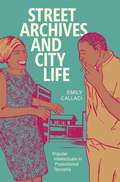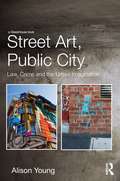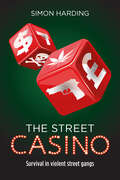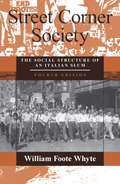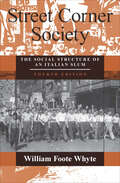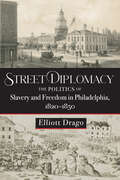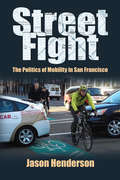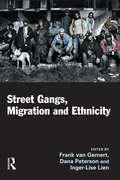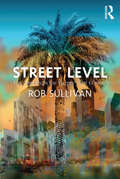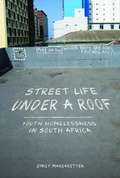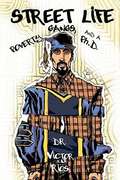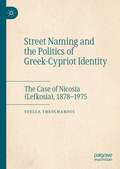- Table View
- List View
Straying from the Straight Path: How Senses of Failure Invigorate Lived Religion
by David Kloos Daan BeekersIf piety, faith, and conviction constitute one side of the religious coin, then imperfection, uncertainty, and ambivalence constitute the other. Yet, scholars tend to separate these two domains and place experiences of inadequacy in everyday religious life – such as a wavering commitment, religious negligence or weakness in faith – outside the domain of religion 'proper.' Straying from the Straight Path breaks with this tendency by examining how self-perceived failure is, in many cases, part and parcel of religious practice and experience. Responding to the need for comparative approaches in the face of the largely separated fields of the anthropology of Islam and Christianity, this volume gives full attention to moral failure as a constitutive and potentially energizing force in the religious lives of both Muslims and Christians in different parts of the world.
Streaming Media and Cultural Memory in a Postdigital Society (Routledge Studies in New Media and Cyberculture)
by Renira Rampazzo Gambarato Johannes HeumanThis book offers a relevant contribution to the studies of streaming media and transmediality with an original approach of cultural sustainability perfectly intertwined with cultural memory beyond borders.By critically reflecting on popular streaming media series, the book identifies their impact on the global circulation of cultural memory, their learning potential for educational purposes, and the societal challenges and opportunities that emerge from the ubiquitous streaming media penetration and potential for participatory practices. It also investigates how series available worldwide on commercial platforms such as Netflix and Max contribute to the global circulation of cultural memories, in addition to illuminating the ethical, (un)sustainable, and educational concerns involved in the fictionalization of the past.Drawing on the authors’ expertise in media studies and history, this transdisciplinary book will interest scholars in the fields of media studies, cultural studies, memory studies, history, transmedia studies, education, postdigital studies, television studies, social communication, sociology, and philosophy.
Streaming Music: Practices, Media, Cultures
by Sofia Johansson Ann Werner Patrik Åker Greg GoldenzwaigStreaming Music examines how the Internet has become integrated in contemporary music use, by focusing on streaming as a practice and a technology for music consumption. The backdrop to this enquiry is the digitization of society and culture, where the music industry has undergone profound disruptions, and where music streaming has altered listening modes and meanings of music in everyday life. The objective of Streaming Music is to shed light on what these transformations mean for listeners, by looking at their adaptation in specific cultural contexts, but also by considering how online music platforms and streaming services guide music listeners in specific ways. Drawing on case studies from Moscow and Stockholm, and providing analysis of Spotify, VK and YouTube as popular but distinct sites for music, Streaming Music discusses, through a qualitative, cross-cultural, study, questions around music and value, music sharing, modes of engaging with music, and the way that contemporary music listening is increasingly part of mobile, automated and computational processes. Offering a nuanced perspective on these issues, it adds to research about music and digital media, shedding new light on music cultures as they appear today. As such, this volume will appeal to scholars of media, sociology and music with interests in digital technologies.
Streaming Sounds: Musical Listening in the Digital Age (Sound in Urban and Popular Culture)
by Michael James WalshIn a time when music streaming has become the dominant mode of consuming music recordings, this book interrogates how users go about listening to music in their everyday lives in a context where streaming services are focused on not only the circulation of music for users but also the circulation of user data and attention.Drawing insights directly from interviews with users, music streaming is explained as never merely a neutral technology but rather one that seeks to actively shape user engagement. Users respond to streaming platforms with some relishing these aspects that provide music to be drawn into daily activities while others show signs of resistance. It is this tension that this book explores. This unique and accessible study will be ideal reading for both scholars and students of popular music studies, communication studies, sociology, media and cultural studies.
Streaming Video: Storytelling Across Borders (Critical Cultural Communication)
by Amanda D. Lotz and Ramon LobatoAn international team of experts explores how streaming services are disrupting traditional storytelling.The rise of streaming has dramatically transformed how audiences consume media. Over the last decade, subscription video-on-demand (SVOD) services, including Netflix, Prime Video, and Disney+, have begun commissioning and financing their own original movies and TV shows, changing the way and the rate at which content is produced across the globe, from Mexico City to Mumbai. Streaming Video maps this international production boom and what it means for producers, audiences, and storytellers. Through eighteen richly textured case studies, ranging from original Korean dramas on Netflix to BluTV’s experimental Turkish series, the book investigates how streaming services both disrupt and maintain storytelling traditions in specific national contexts. To what extent, and how, are streamers expanding norms of television and film storytelling in different parts of the world? Are streamers enabling the creation of content that would not otherwise exist? What are the implications for different viewers, in different countries, with different tastes? Together, the chapters critically assess the impacts of streaming on twenty-first century audiovisual storytelling and rethink established understandings of transnational screen flows.
Streaming and Screen Culture in Asia-Pacific
by Michael Samuel Louisa MitchellThis book is an interdisciplinary collection exploring the impact of emergent technologies on the production, distribution and reception of media content in the Asia-Pacific region. Exploring case studies from China, Japan, South Korea, India, Thailand and Australia, as well as American co-productions, this collection takes a Cultural Studies approach to the constantly evolving ways of accessing and interacting with visual content. The study of the social and technological impact of online on-demand services is a burgeoning field of investigation, dating back to the early-2010s. This project will be a valuable update to existing conversations, and a cornerstone for future discussions about topics such as online technologies, popular culture, soft power, and social media.
Streamlining Political Communication Concepts: Updates, Changes, Normalcies (Springer Studies in Media and Political Communication)
by Stylianos Papathanassopoulos Susana SalgadoIn this edited volume, renowned scholars from around the globe rethink and update important political communication concepts in the light of the most recent changes that have been occurring in media environments. In particular, the authors discuss those caused by the use of social media in politics, e.g. prevalent disinformation, populism, political polarization, etc. This collection of key texts addresses the major concerns that arise in our rapidly changing media and political environments and provides a basis for discussions on the current state of political communication research.This makes this volume a must-read for students, researchers, and scholars of political communication, interested in a better understanding of key concepts and the current state of the research in the field.
Streampunks: Youtube y los rebeldes que estan transformando los medios
by Robert Kyncl<P>En los últimos diez años, la plataforma de videos por internet YouTube ha cambiado los medios y el entretenimiento tan profundamente como lo hicieron la invención del cine, la radio y la televisión. <P>Streampunks es una mirada a esta empresa advenediza que examina cómo ha evolucionado YouTube y hacia dónde va. <P>Basándose en relatos de las estrellas más influyentes de YouTube (Streampunks como Tyler Oakley, Lilly Singh y Casey Neistat) y los negociadores que promueven el futuro del entretenimiento (como Scooter Braun y Shane Smith), Robert Kyncl utiliza sus experiencias en tres de las compañías de medios más innovadoras, HBO, Netflix y Youtube, para contar la historia del streaming y de este monstruo moderno de la cultura pop. <P>En colaboración con Maany Peyvan (escritor de contenido de Google), Kyncl explica cómo se dictan las nuevas reglas del entretenimiento y cómo y por qué el panorama de los medios está cambiando radicalmente.
Streben nach Momentum: Musikkultur zwischen Marken und Medienplattformen (Musikwirtschafts- und Musikkulturforschung)
by Lorenz Grünewald-SchukallaSeit der industriellen Produktion von Notendrucken nutzen Unternehmen Musik, um ihre Marken zu entwickeln und zu etablieren. Diese Studie beleuchtet die vielfältigen Formen der Verbindung von Marken und Musik, von den gebrandeten Radioshows im frühen 20. Jahrhundert bis hin zu den modernen, integrierten Musik-Dachmarken von Red Bull, der Telekom oder Seat. Sie zeigt, wie die Beziehungen zwischen Marken und Musik im Verlauf der Geschichte verändert wurden. Dabei lenkt sie erstmals den Blick auf die Rolle neuer Medienentwicklungen in diesem Prozess. Anhand der innovativen Methode einer digitalen, fokussierten und verteilten Ethnographie wird die besondere Rolle digitaler Plattformen für gegenwärtige gebrandete Musikkultur in den Blick genommen. Der Autor zeigt anschaulich, wie Markenunternehmen Orte und Events so arrangieren, dass medienbezogene Praktiken auf Plattformen ausgerichtet werden. So steigern Unternehmen die Wahrscheinlichkeit gebrandeter Kommunikationsströme und erzeugen ein „Momentum“, das den Wert einer Marke, die Karrieren von Musikschaffenden, aber auch gewöhnliche Musikerfahrung beflügeln kann. In der Summe führt dies zu einer neuen Musikkultur, einer Musikkultur zwischen Marken und Medienplattformen. In dieser können zwar viele an Musikkultur teilhaben, sind jedoch dem Zwang ausgesetzt, etwas zum Momentum einer Marke beizutragen.
Street Archives and City Life: Popular Intellectuals in Postcolonial Tanzania
by Emily CallaciIn Street Archives and City Life Emily Callaci maps a new terrain of political and cultural production in mid- to late twentieth-century Tanzanian urban landscapes. While the postcolonial Tanzanian ruling party (TANU) adopted a policy of rural socialism known as Ujamaa between 1967 and 1985, an influx of youth migrants to the city of Dar es Salaam generated innovative forms of urbanism through the production and circulation of what Callaci calls street archives. These urban intellectuals neither supported nor contested the ruling party's anti-city philosophy; rather, they navigated the complexities of inhabiting unplanned African cities during economic crisis and social transformation through various forms of popular texts that included women's Christian advice literature, newspaper columns, self-published pulp fiction novellas, and song lyrics. Through these textual networks, Callaci shows how youth migrants and urban intellectuals in Dar es Salaam fashioned a collective ethos of postcolonial African citizenship. This spirit ushered in a revolution rooted in the city and its networks—an urban revolution that arose in spite of the nation-state's pro-rural ideology.
Street Art, Public City: Law, Crime and the Urban Imagination
by Alison YoungWhat is street art? Who is the street artist? Why is street art a crime? Since the late 1990s, a distinctive cultural practice has emerged in many cities: street art, involving the placement of uncommissioned artworks in public places. Sometimes regarded as a variant of graffiti, sometimes called a new art movement, its practitioners engage in illicit activities while at the same time the resulting artworks can command high prices at auction and have become collectable aesthetic commodities. Such paradoxical responses show that street art challenges conventional understandings of culture, law, crime and art. Street Art, Public City: Law, Crime and the Urban Imagination engages with those paradoxes in order to understand how street art reveals new modes of citizenship in the contemporary city. It examines the histories of street art and the motivations of street artists, and the experiences both of making street art and looking at street art in public space. It considers the ways in which street art has become an integral part of the identity of cities such as London, New York, Berlin, and Melbourne, at the same time as street art has become increasingly criminalised. It investigates the implications of street art for conceptions of property and authority, and suggests that street art and the urban imagination can point us towards a different kind of city: the public city. Street Art, Public City will be of interest to readers concerned with art, culture, law, cities and urban space, and also to readers in the fields of legal studies, cultural criminology, urban geography, cultural studies and art more generally.
Street Casino: Survival in Violent Street Gangs
by Simon HardingGang violence is on the increase in certain neighbourhoods. There is an urgent need for a fresh perspective that offers insight into gang structure, organisation and offending behaviour to explain this increase. Using the findings from an extensive ethnographic study of local residents, professionals and gang members in south London, and drawing on his vast experience and knowledge of the field, Simon Harding proposes a unique theoretical perspective on survival in violent street gangs. He applies Bourdieu’s principles of social field analysis and habitus to gangs, establishing them as a social arena of competition where actors struggle for distinction and survival, striving to become ‘players in the game’ in the ‘casino of life’. Success is determined by accruing and retaining playing chips – street capital. Harding’s dramatic and compelling insights depict gang life as one of constant flux, where players jostle for position, reputation, status and distinction. This perspective offers new evidence to the field that will help academics, students, practitioners and policy makers to understand the dynamics of gang behaviour and the associated risks of violence and offending. Simon Harding is currently a senior lecturer in criminology at Middlesex University, UK. He draws on 25 years of experience in research, public policy and project delivery as a crime reduction and community safety practitioner.
Street Cop: Policing in Context
by George C. KleinThis book provides an ethnography of street-level policing in the United States and offers an analysis with valuable lessons for today’s law enforcement officers. Author George C. Klein, sociologist and former police officer, explores the characteristics of policing in a suburb outside of large Midwestern city in the United States. As a participant-observation fieldworker, he functioned as an ethnographic researcher, recording with a sociological eye the "real world" tasks of policing, including the ordinary as well as the more remarkable aspects of day-to-day law enforcement. He approaches the data with three levels of analysis, looking at embedded issues in policing, such as discretion, danger, corruption, cynicism, race, and class; a mid-range analysis that examines police work as an example of street-level bureaucracy; and a global analysis assessing the entrenched roles of race, class, and demography in police work, as well as, society, in the U.S. This book focuses on the need for police officers to solve social problems that other institutions in society are unwilling, or unable, to solve. It examines a myriad of issues, such as police socialization, the use of force by police officers, stress levels and suicide risk factors, disparate styles of policing, police militarization, de-escalation, and more. With compelling detail, the author helps the reader understand the turmoil regarding policing in the United States today. It is ideal for police professionals as well as students and scholars of criminal justice, criminology, sociology, psychology, history, political science and journalism.
Street Corner Secrets: Sex, Work, and Migration in the City of Mumbai
by Svati P. ShahStreet Corner Secrets challenges widespread notions of sex work in India by examining solicitation in three spaces within the city of Mumbai that are seldom placed within the same analytic frame--brothels, streets, and public day-wage labor markets (nakas), where sexual commerce may be solicited discretely alongside other income-generating activities. Focusing on women who migrated to Mumbai from rural, economically underdeveloped areas within India, Svati P. Shah argues that selling sexual services is one of a number of ways women working as laborers may earn a living, demonstrating that sex work, like day labor, is a part of India's vast informal economy. Here, various means of earning--legitimized or stigmatized, legal or illegal--overlap or exist in close proximity to one another, shaping a narrow field of livelihood options that women navigate daily. In the course of this rich ethnography, Shah discusses policing practices, migrants' access to housing and water, the idea of public space, critiques of states and citizenship, and the discursive location of violence within debates on sexual commerce. Throughout, the book analyzes the epistemology of prostitution, and the silences and secrets that constitute the discourse of sexual commerce on Mumbai's streets.
Street Corner Society: The Social Structure of an Italian Slum (4th edition)
by William Foote WhyteIn the heart of "Eastern City" there is a slum district known as Cornerville, which is inhabited almost exclusively by Italian immigrants and their children. To the rest of the city it is a mysterious, dangerous, and depressing area. Cornerville is only a few minutes' walk from fashionable High Street, but the High Street inhabitant who takes that walk passes from the familiar to the unknown.
Street Corner Society: The Social Structure of an Italian Slum (Materiale Soziologie Ser. #6)
by William Foote WhyteThe classic study of a poor community in Boston&’s North End in the mid-twentieth century. Street Corner Society is one of a handful of works that can justifiably be called classics of sociological research. William Foote Whyte's account of the Italian American slum he called &“Cornerville&”—Boston's North End—has been the model for urban ethnography for fifty years. By mapping the intricate social worlds of street gangs and &“corner boys,&” Whyte was among the first to demonstrate that a poor community need not be socially disorganized. His writing set a standard for vivid portrayals of real people in real situations. And his frank discussion of his methodology—participant observation—has served as an essential casebook in field research for generations of students and scholars. This fiftieth anniversary edition includes a new preface and revisions to the methodological appendix. In a new section on the book&’s legacy, Whyte responds to challenges to the validity, interpretation, and uses of his data. &“The Whyte Impact on the Underdog,&” the moving statement by a gang leader who became the author&’s first research assistant, is preserved. &“Street Corner Society broke new ground and set a standard for field research in American cities that remains a source of intellectual challenge.&”—Robert Washington, Reviews in Anthropology
Street Crime (Crime and Society Series)
by Simon HallsworthStreet crime remains high on the public and political agenda, and is frequently the subject of media attention and concern. This book aims to provide a detailed and accessible account of the phenomenon, placing the subject in its theoretical, historical and political context. It addresses the question of how serious a problem street crime really is, and why it has become such a hot political issue. The book draws upon contemporary debates about the supposed presence of an emerging underclass, and in particular the 'criminalisation' and 'racialisation' of black communities with whom it has come to be particular associated in the public mind. The author then develops a framework of analysis which focuses upon the relationship of three key variables: the production of motivated offenders, the availability and suitability of victims, and a study of the limits inherent in current control strategies. Finally, the book concludes that a successful prevention strategy requires an agenda for revitalising the public sphere in inner city areas --rather than reliance policies of situational crime prevention, zero tolerance policing and increased punishment.
Street Diplomacy: The Politics of Slavery and Freedom in Philadelphia, 1820–1850
by Elliott DragoAn illuminating look at how Philadelphia's antebellum free Black community defended themselves against kidnappings and how this "street diplomacy" forced Pennsylvanians to confront the politics of slavery.As the most southern of northern cities in a state that bordered three slave states, antebellum Philadelphia maintained a long tradition of both abolitionism and fugitive slave activity. Although Philadelphia's Black community lived in a free city in a free state, they faced constant threats to their personal safety and freedom. Enslavers, kidnappers, and slave catchers prowled the streets of Philadelphia in search of potential victims, violent anti-Black riots erupted in the city, and white politicians legislated to undermine Black freedom. In Street Diplomacy, Elliott Drago illustrates how the political and physical conflicts that arose over fugitive slave removals and the kidnappings of free Black people forced Philadelphians to confront the politics of slavery. Pennsylvania was legally a free state, at the street level and in the lived experience of its Black citizens, but Pennsylvania was closer to a slave state due to porous borders and the complicity of white officials. Legal contests between slavery and freedom at the local level triggered legislative processes at the state and national level, which underscored the inability of white politicians to resolve the paradoxes of what it meant for a Black American to inhabit a free state within a slave society. Piecing together fragmentary source material from archives, correspondence, genealogies, and newspapers, Drago examines these conflicts in Philadelphia from 1820 to 1850. Studying these timely struggles over race, politics, enslavement, and freedom in Philadelphia will encourage scholars to reexamine how Black freedom was not secure in Pennsylvania or in the wider United States.
Street Fight: The Politics of Mobility in San Francisco
by Jason HendersonFaced with intolerable congestion and noxious pollution, cities around the world are rethinking their reliance on automobiles. In the United States a loosely organized livability movement seeks to reduce car use by reconfiguring urban space into denser, transit-oriented, walkable forms, a development pattern also associated with smart growth and new urbanism. Through a detailed case study of San Francisco, Jason Henderson examines how this is not just a struggle over what type of transportation is best for the city, but a series of ideologically charged political fights over issues of street space, public policy, and social justice. Historically San Francisco has hosted many activist demonstrations over its streets, from the freeway revolts of the 1960s to the first Critical Mass bicycle rides decades later. Today the city's planning and advocacy establishment is changing zoning laws to limit the number of parking spaces, encouraging new car-free housing near transit stations, and applying "transit first" policies, such as restricted bus lanes. Yet Henderson warns that the city's accomplishments should not be romanticized. Despite significant gains by livability advocates, automobiles continue to dominate the streets, and the city's financially strained bus system is slow and often unreliable. Both optimistic and cautionary, Henderson argues that ideology must be understood as part of the struggle for sustainable cities and that three competing points of view--progressive, neoliberal, and conservative--have come to dominate the contemporary discourse about urban mobility. Consistent with its iconic role as an incubator of environmental, labor, civil rights, and peace movements, San Francisco offers a compelling example of how the debate over sustainable urban transportation may unfold both in the United States and globally.
Street Food: Culture, economy, health and governance (Routledge Studies in Food, Society and the Environment)
by Ryzia de Cassia Vieira Cardoso Stefano Roberto Marras MichPrepared foods, for sale in streets, squares or markets, are ubiquitous around the world and throughout history. This volume is one of the first to provide a comprehensive social science perspective on street food, illustrating its immense cultural diversity and economic significance, both in developing and developed countries. Key issues addressed include: policy, regulation and governance of street food and vendors; production and trade patterns ranging from informal subsistence to modern forms of enterprise; the key role played by female vendors; historical roots and cultural meanings of selling and eating food in the street; food safety and nutrition issues. Many chapters provide case studies from specific cities in different regions of the world. These include North America (Atlanta, Philadelphia, Portland, Toronto, Vancouver), Central and South America (Bogota, Buenos Aires, La Paz, Lima, Mexico City, Montevideo, Santiago, Salvador da Bahia), Asia (Bangkok, Dhaka, Penang), Africa (Accra, Abidjan, Bamako, Freetown, Mozambique) and Europe (Amsterdam).
Street Gangs, Migration and Ethnicity
by Dana Peterson Inger-Lise Lien Frank Van GemertThis book is the third publication from the Eurogang Network, a cross-national collaboration of researchers (from both North America and Europe) devoted to comparative and multi-national research on youth gangs. It provides a unique insight into the influence of migration on local gang formation and development, paying particular attention to the importance of ethnicity. The book also explores the challenges that migration and ethnicity pose for responding effectively to the growth of such gangs, particularly in areas where public discourse on such issues is restricted. Chapters in the book are concerned to address both situations where there have been longstanding problems with street gangs as well as areas where such issues have just started to emerge. A variety of different research traditions and approaches are represented, including ethnographic methods, self-report surveys and interviews, official records data and victim interviews. It will be essential reading for anybody interested in the phenomenon of street and youth gangs.
Street Level: Los Angeles In The Twenty-first Century
by Rob SullivanIn the latter part of the C20th, a series of seminal books were written which examined Los Angeles by the likes of Reyner Banham, Mike Davis, Edward Soja, Allen Scott, Michael Dear, Frederick Jameson, Umberto Eco, Bernard-Henri Levy, and Jean Baudrillard which have been hugely influential in thinking about cities more broadly. The debates which were generated by these works have tended to be very heated and either defensive or offensive in approach. A sufficient amount of time has since passed that a more measured approach to evaluating this work can now be taken. The first section of this book, 'Contra This and Contra That', provides such a critique of the various theories applied to Los Angeles during the last century, balancing the positive with the negative. The second part of the book is an investigation of L.A. as it exists on the ground today. While political, the theoretical stance taken in this investigation is not mounted as a platform from which to advocate a particular ideology. Instead, it encompasses cultural as well as economic issues to put forth a view of L.A. which is coherent and cogent while at the same time considering its multi-layed, complex and ever-changing qualities. It concludes by arguing that sectored off and 'totalizing' visions of the city will not do as instruments of urban analysis and that only a theory as mobile as its target will do: one that replicates the polymer nature of this place. It proposes that, extending that theory to the world beyond this particular city, only a theory that models itself on the mobile and polymer nature of the world, while still retaining a sense of the actual and the real, will do as an instrument with which to comprehend the world. In doing so, this book is not only a model by which to think through Los Angeles, but as a model by which to think through other world cities.
Street Life under a Roof: Youth Homelessness in South Africa
by Emily MargarettenPoint Place stands near the city center of Durban, South Africa. Condemned and off the grid, the five-story apartment building is nonetheless home to a hundred-plus teenagers and young adults marginalized by poverty and chronic unemployment. In Street Life under a Roof , Emily Margaretten draws on ten years of up-close fieldwork to explore the distinct cultural universe of the Point Place community. Margaretten's sensitive investigations reveal how young men and women draw on customary notions of respect and support to forge an ethos of connection and care that allows them to live far richer lives than ordinarily assumed. Her discussion of gender dynamics highlights terms like nakana --to care about or take notice of another--that young women and men use to construct "outside" and "inside" boyfriends and girlfriends and to communicate notions of trust. Margaretten exposes the structures of inequality at a local, regional, and global level that contribute to socioeconomic and political dislocation. But she also challenges the idea that Point Place's marginalized residents need "rehabilitation." As she argues, these young men and women want love, secure homes, and the means to provide for their dependents--in short, the same hopes and aspirations mirrored across South African society.
Street Life: Poverty, Gangs, and a Ph. D.
by Victor RiosVictor Rios grew up in Oakland, California in a single parent household, in poverty and on welfare. He joined a gang at the age of thirteen and by age sixteen he had dropped out of school and had been incarcerated several times. Having witnessed the tragic murder of his best friend by gang rivals, Victor hit a critical juncture in life at which point he made the decision to transform. With the support of educators and mentors, Victor redirected his attitude towards life, and returned to school to eventually acquire a Ph. D. from the University of California at Berkeley. Dr. Rios uses his personal story, and 10 years of research experience, to discuss how personal and institutional "illusions" contribute to academic failure. He speaks about how society gives young people little choice but to use their "attitude" to solve their problems and how this strategy often leads to detrimental consequences. He discusses practical pathways to transformation relevant to the lives of students. Dr. Rios speaks about his own personal transformation by taking advantage of the support that teachers and programs provided him and discusses how these efforts can be replicated. This book is written to speak to a young adult audience "those young people who live on the margins, who are often assigned texts that do not represent their lived reality, their struggles, or their experiences. Educators and youth workers can use each of the short chapters in this book as tools for discussing complicated social issues like abuse, youth violence, delinquency, fatalism, opportunity, stratification, poverty, resilience, college, positive role models, healthy choices, and personal transformation.
Street Naming and the Politics of Greek-Cypriot Identity: The Case of Nicosia (Lefkosia), 1878–1975
by Stella TheocharousThis book is the first to explore street names and street-naming in the formation of a Greek-Cypriot identity in the cityscape of Nicosia between 1878 and 1975. Rather than treating toponymy as a direct linguistic act of spatial orientation, the book approaches street-naming as a contested practice involving those shared symbols and representations used to depict official history and collective identity as part of a political process. It considers how street names are part of the symbolic politics of space, and how authorities transformed the streets of Nicosia into arenas of struggle for the control of symbolic and material space. It documents historical efforts over the course of a century to impose a ‘geography of forgetting’ to buttress national identity and to cast out the ‘other’ from space — both literally and symbolically — so as to achieve territorial dominance and political legitimacy. The book is another step towards the development of a global perspective on the critical study of street-naming, thereby refining and expanding our knowledge of the political dynamics involved in the process. In their commemorative capacity, street names belong to the politics of public memory and identity.
